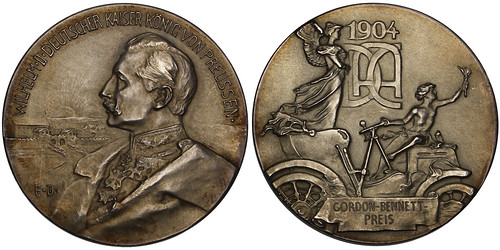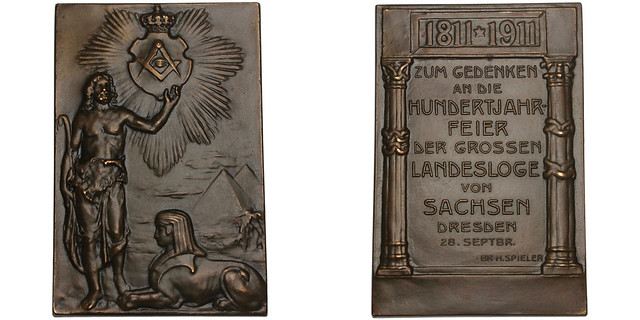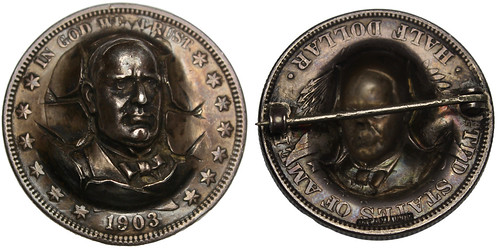
PREV ARTICLE
NEXT ARTICLE
FULL ISSUE
PREV FULL ISSUE
NUMISMAGRAM MEDAL SELECTIONS: AUGUST 2020Jeremy Bostwick at Numismagram recently added 24 lots of European art medals and plaques—along with a few other interesting pieces of exonumia—to his website. In addition to the pieces below, various topics are represented, such as World War I, sports, exploration, soaps and perfumes in Sweden, even Halley's comet. Please visit numismagram.com/inventory for all of these new additions, and check back later this month for a small selection French biographical medals of rather interesting historical figures. -Editor
Gordon Bennett Cup Silver Award Medal 
101180 | GERMANY. Gordon Bennett Cup silver Award Medal. Issued 1904 for the 342-mile race near Bad Homburg vor der Höhe (33mm, 16.97 g, 12h). By L. C. Lauer in Nürnberg. WILHELM • II • DEUTSCHER KAISER KÖNIG VON PREUSSEN •, bust of Wilhelm left; in background, rising sun over cityscape of Bad Homburg / Date above DAC monogram (Deutscher Automobilclub); Genius, holding torch, driving antique automobile right; to left, Victory standing right at back of auto. Edge: SILBER 0,990. Wurzbach 9694. Choice Mint State. Pleasing argent surfaces, with some golden-russet toning near the peripheries and a great matte nature. Great early automotive type. $365. The 1904 Gordon Bennett Cup, formally styled as the V Coupe Internationale, was an automobile race run on 17 June 1904 around the Taunus mountain range north of Frankfurt. As the 1903 race winner was from Germany, the privilege of hosting the 1904 race fell to that country, with Kaiser Wilhelm II suggesting this mountain range. The course, nearly 80 miles in length, hosted four laps, with the eventual winner—Léon Théry of France—beating a field of 17 other drivers hailing from six countries, all with an 11 minute margin of victory.
I like it! -Editor
To read the complete item description, see:
1911 Dresden Masonic Bronze Plaque 
101263 | GERMANY. Dresden. Masonic bronze Plaque. Issued 1911 for the 100th anniversary of the founding of the Grand Lodge of Saxony (39x59mm, 58.28 g, 12h). By H. Speiler. St. John the Baptist standing slightly right, holding crozier and raising hand; to right, Sphinx left; in background, crowned and radiant Masonic arms above the pyramids / ZUM GEDENKEN / AN DIE / HUNDERTJAHR– / FEIER / DER GROSSEN / LANDESLOGE / VON / SACHSEN / DRESDEN / 28 SEPTBR in ten lines; all between Doric (strength) and Corinthian (beauty) columns. Edge: Plain. Choice Mint State. Pleasing brown surfaces, with a few minor spots of red corrosion. A scarce and interesting masonic type. $245. The Grand Lodge of Saxony was formed in 1811 in Dresden, with it reaching a peak membership of 7,200 freemasons in 1930. Just five years later, it was dissolved on account of increasing pressure placed upon the chapters by the Third Reich's Gestapo and SS.
To read the complete item description, see:
1714 Holy Roman Empire Treaty Medal 
101215 | HOLY ROMAN EMPIRE & FRANCE. Karl VI and Louis XIV tin Medal. Issued 1714. Commemorating the Treaties of Rastatt and Baden, as well as the end of the War of the Spanish Succession (48mm, 36.70 g, 12h). By G. Vestner. FEL • TEMP • REPARATIO / CAROLVS VI • D • G • ROM • IMP • ET LVD • XIIII • D • G • FR • ET NAV • REX •, laureate, draped, and armored busts of Karl and Louis facing one another / HIS IVNCTIS IVNGITVR ORBIS (the world is joined by those adjoining), crowned Jupiter (Karl), with eagle bearing thunderbolt, and radiant Apollo (Louis), with lyre and bow, placing between them a drapery over the globe split from the ravages of war; the split runs vertically down western Europe, dividing GALLIA (France) and GERMANIA (the Holy Roman Empire); in three lines in exergue, VNA DVOS ITERATA DEOS / CONCORDIA STRIN / GIT (a renewed harmony is drawn together by the two gods). Edge: Plain. Bernheimer 50; Pax in Nummis 473; cf. Julius 1242 (silver); cf. Montenuovo 1432 (same); Montagu II 666 (same); van Loon V, pp. 244-5 (metal unspecified). Choice Mint State. Exceedingly lustrous and brilliant, with highly mirrored fields and some frosting to the devices; a few light, unobtrusive hairlines are mentioned for completeness. A very rare and interesting medal, especially in tin; typical copper plug intact. Compare to similar pieces in silver—such as Künker 105 (27 September 2005), lot 2783; Künker 232 (17 June 2013), lot 348; and Peus 424 (15 May 2019), lot 829, which realized respective hammers of €9,100, €6,500, and €5,000 [all before buyer's fees]. $1,795. The War of the Spanish Succession stemmed from the death in 1700 of the childless Carlos (Charles) II of Spain. Owing to the nexus of power presented by the Spanish throne, namely control in parts of Italy, the Spanish Netherlands, and vast territories in the New World, it offered great strategic importance. On account of the Habsburg familial ties to the Holy Roman Empire, it also presented a potential shift in the European balance of power. The deceased Carlos had named Philippe of Anjou as his successor, who ultimately agreed to the throne. The remainder of Europe, however, including the Holy Roman Empire, England, and the Dutch Republic, opposed this proclamation, with war breaking out among the various realms. Ultimately, the conflict changed little, as nothing decisive occurred through the hostilities, and the respective powers sought an end to the conflict, first at the Treaty of Utrecht in 1713, then at the Treaties of Rastatt and Baden in 1714. Philippe would stay as king of Spain (as Felipe V), though he renounced any future French claims for himself or his successors. Additionally, Spain ceded some of her Italian possessions while retaining those in the New World. England garnered recognition of the Hanoverian line along with a repudiation of the Jacobite cause in France. The Holy Roman Empire saw a decrease in overall expanse from her heyday a little over a century prior; as such, her attention turned to her southern borders and increasing conflicts with the Ottoman Empire. Regarding this medal, a further point of interest is in the artistry itself, with Emperor Karl being depicted as Jupiter and French King Louis (the sun king) as Apollo—a great nod to the classics with respect to the two power brokers of the conflict.
Great medal! -Editor
To read the complete item description, see:
Russian Coin Purse 
101283 | RUSSIA. Silver Coin Purse. Issued circa 1900. Engraving imitating 5% interest bearing 100 ruble note (71x57mm, 87.40 g, 12h). By "??." All elements engraved: imperial double eagle seal between two smaller seals reading "???I?" and "IN÷;" below, "?????? / ??????????? 5 ?? ?????????? ????? / ?? ???????? ?? ??? ?????? / ??????? ?????? ???? ??????" (ticket for a 5% domestic loan valued at 100 rubles and an annual increase of 5 rubles) in four lines; below, corrupted German intended to read "OBLIGATION DER ZWEITEN RUSSISCHEN 5% INNEREN ANLEIHE / MIT PRAEMIEN–VERLOOSUNGEN / Ein Hundert Rubel;" stylized "100" behind corrupted German text and script; pseudo-legend border around / Ornate "200000." Hallmarks: "??" and "84 silver" on each side. Overall, choice extremely fine. Lightly toned. Still in working order, with complete inner lining intact and three separate pouches for holding coins. Quite rare, especially this attractive, and a very interesting numismatic and notaphilic piece of art. $795. Monetary changes in the mid-1890's resulted in an influx of gold coinage into the Russian economy—a shift for a population that had grown accustomed to fiat for larger transactions. As such, the usage of both gold and silver coinage in transactions became a more ubiquitous aspect of life around the turn of the century. Owing to this influx of hard currency, a more convenient manner of carrying change became necessary, thus creating the usefulness of coin purses (??????). Since they were now en vogue, various silversmiths tried their hand at creating a product for the consumer, with one design in particular becoming rather popular with the Russian populace. Mimicking the layout of a loan "ticket" from 1864, these silversmiths engraved iconography that had the appearance of paper currency, though these "notes" from the past were actually bonds meant to raise funds for the completion of the vital rail line between Moscow and the Black Sea. Over time, the tickets would earn their bearer additional funds, but to add more intrigue and excitement, winning serial numbers were drawn twice per year, giving the bearers a chance to earn many times what they could expect during the normal duration of the bond. The largest such prize was some 200,000 rubles, accounting for the "200,000" on the reverse of this coin purse. In essence, these purses were meant to capture the desire of the bearer winning—against all odds—a lottery that could see them become instantly rich.
Unusual - a neat paper money crossover item. -Editor
To read the complete item description, see:
William McKinley silver Repoussé Badge. 
101276 | UNITED STATES William McKinley silver Repoussé Badge. Issued circa 1912 on a 1903-dated Barber Half Dollar (30mm, 13.03 g). Pop-out facing head of McKinley in place of the head of Liberty. Edge: Reeded, with pin attached. Stump –. Pop-out & host coin: Choice Extremely Fine. Pleasantly toned. A great piece of numismatic ephemera from the early 20th century. $495. "Repoussés" are an interesting form of coin art appearing in the early part of the 1900’s. The host coin was heated to a very high temperature, thus softening the metal and making it a candidate for "re-punching." Dies with a facing (usually) head of some kind would take the place of the original device on the obverse, with an incuse version of this obverse design now evident on the reverse. The result would offer a tremendous 3-D effect, whereby the face on the coin was seemingly bursting out of the piece. In reality, the process was simply an update of the bracteates that used to circulate in areas such as medieval Germany and Switzerland—the coins merely having an obverse design, with the reverse being an incuse, inverted version of the obverse. In the case of this piece, the McKinley "pop-out" was likely issued during one of Theodore Roosevelt's presidential campaigns—possibly that of 1912 when he ran under the third party Bull Moose ticket—for which these could have served as political badges. Roosevelt was McKinley's vice president, who succeeded him upon McKinley's assassination in Buffalo in 1901.
Great item, perhaps manufactured by the August Frank company. -Editor
To read the complete item description, see:

Wayne Homren, Editor The Numismatic Bibliomania Society is a non-profit organization promoting numismatic literature. See our web site at coinbooks.org. To submit items for publication in The E-Sylum, write to the Editor at this address: whomren@gmail.com To subscribe go to: https://my.binhost.com/lists/listinfo/esylum All Rights Reserved. NBS Home Page Contact the NBS webmaster 
|